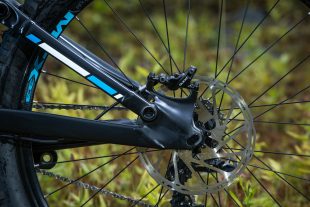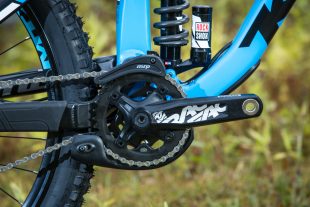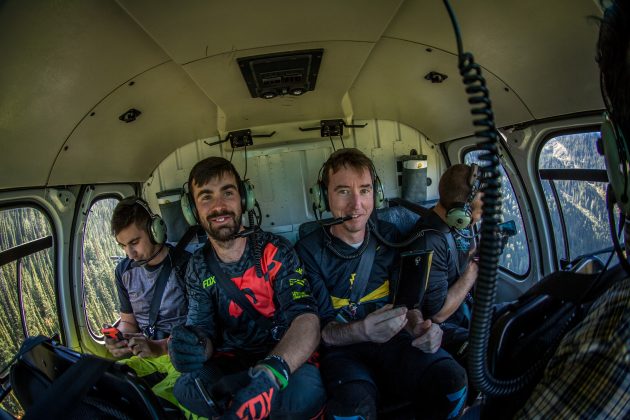First Ride: 2017 Kona Operator
Originally posted on October 18, 2016 at 14:00 pmPhotos by Caleb Smith and the author.
Let me start this out with some honesty. The last time I was on a downhill hike was almost two years ago, and even then I was nursing a torn rotator cuff. While I’ve always enjoyed true DH riding, it doesn’t happen very often, so keep that in mind as you read about my experiences about riding Kona’s new Operator.
Rusty DH skills or not, there was no way I was going to pass up a trip to Retallack Lodge, so I packed up my full-face and my declining bag of skills and headed north. (On this trip I also spent trail-time on the new Hei Hei Trail which is more my speed. We’ll post about the Hei Hei soon.)

The new Operator differs in two obviously major ways from the previous bike. One, the wheel size moved up to 27.5 from the 26 inch. Two, the frame is now aluminum versus the carbon fiber of the old bike. Less obvious are the geometry changes that move this bike into the modern realm of Long-Low-Slack.


Keep in mind this design has to work for all Kona riders, including World Cup downhillers and Red Bull Rampagers. For example, we got to ride a bit with World Cup pro Conor Fearon a bit at Retallack. Well, some of us did. I’m not fast enough to stay very close to a guy that finished seventh at the World Championships this year. Freeride star Graham Agassiz was also around, finishing up some trail building and filming on a project on the mountains above the lodge—look for more on that in the spring, it should be wild. Later he crashed hard at Rampage, breaking his pelvis. Ouch. He won’t be piloting his Operator for a few months as he heals up.


Anyway, back to those changes. I had assumed aluminum as a frame material on high-end downhill bikes isn’t that common these days, but a quick poll of the top ten UCI riders (men and women) show it to be more even than I expected, with a eight carbon bikes, eleven aluminum bikes, and one carbon front/aluminum rear. Breaking it down by gender is interesting: Men: six carbon/three aluminum/one mixed. Women: two carbon/eight aluminum. Not sure what to think of that breakdown, but it does show aluminum is more than capable as a frame material, even at the highest level of the sport.
I’ve always been in the camp the frame material is not as important as geometry, so let’s look at that compared to 2016’s bike:
| Size large | 2016 | 2017 |
| ST LENGTH | 417 mm | 410 mm |
| TT LENGTH | 573 mm | 611 mm |
| REACH | 422 mm | 460 mm |
| STACK | 590 mm | 620 mm |
| STANDOVER | 725 mm | 720 mm |
| HT ANGLE | 64 degrees | 63 degrees |
| HT LENGTH | 110 mm | 125 mm |
| ST ANGLE | 76 degrees | 76.5 degrees |
| CS LENGTH | 420 mm | 423 mm |
| BB DROP | 4 mm | 10 mm |
| BB HEIGHT | not listed | 349 mm |
| WHEELBASE | 1178 mm | 1248 mm |
| FRONT CENTER | 758 mm | 825 mm |
| FORK LENGTH | 568 mm | 581 mm |
| FORK OFFSET | 42 mm | 48 mm |
Obviously this thing got a lot longer. Chainstay length remains very similar, but reach grows by almost 40 mm, the head angle drops to 63 degrees and the wheelbase grows by 70 mm. These are big numbers, but nothing that hasn’t been proven by other bikes on the market. Kona claims the aluminum frame is less than a pound heavier than the previous carbon frame.
My first run on the day was on a size medium, but I quickly swapped it out for a large. Knowing how steep things were going to get I wanted as much bike in front of me as possible. In an ideal world, I probably should have swapped to the lighter springs of the medium, but schedules were tight, and in the end, I would be just be slightly less comfortable and still slow with the stiffer springs.
I rode the entry level Operator (not the DL or Supreme). It is well-spec’ed for a $3,200 bike: RockShox Kage R shock, Boxxer RC fork, Guide R brakes and Maxxis DHF tires are all decent performers out of the box, and not really that different that what comes on the DL. The DL gets a more adjustable Kage RC shock and 3C rubber on the DHFs. Obviously there are wheel and drivetrain upgrades as well, but the important bits are dialed on the base model. Interestingly enough, the Kage (not the Vivid) shock appears on all three Operators, even the Supreme. Kona found this shock to work very well and helps to keep the cost in check, although most other brands’ high-end bikes sport a high-end shock. After some chatting about it in theory before riding, there seemed to be much less chatter after riding the bikes. Although maybe it all happened before I could catch up.

Ride Impressions
I expected this bike to feel “big”, but it really didn’t. The entry level bike didn’t exactly hide its weight (guessing it to be at least 40 pounds) but it wasn’t unwieldy feeling on the mixture of trails we hit throughout the day. As is typical for modern downhill bikes, the Operator feels most at home in full attack mode. Full attack mode can be seen in this video, and was rarely seen with me at the controls.
I can’t speak to how this bike handles at the speeds it is truly capable of, but for an at-best-mediocre downhiller, the Operator isn’t so extreme as to be overwhelming. In other words this seems to be an excellent bike for riders getting more serious about the sport. With all of Kona gravity athletes on stock Operator frames, there is obviously plenty of performance here to be unlocked with more riding.

Kona is sticking with its guns on the suspension design. Single pivot still rules the roost here, but there are still some updates to the design to talk about. The main pivot has been moved to decrease chain growth and drivetrain influence on the suspension design. The seatstay pivot has been moved as well, for a claimed decrease in brake-included suspension stiffening. Cartridge bearings are added at the upper shock mount in an effort to increase suspension suppleness. I noticed some brake influenced suspension stiffening when braking hard in rough terrain, but it wasn’t overwhelming. Pedalling performance is….? Who knows, we went down most of time, there was probably little need for a chain on a lot our rides. The whole bike felt reassuringly stiff and predictable, lovely traits in a downhill bike.
Since we had a single day on unfamiliar trails on this bike I can’t really say much else about the ride. I had a good time, both on the mountain and at the lodge. Retallack has excellent guides, excellent chefs and excellent bartenders. The lodge is clean and well appointed, but not at all stuffy or pretentious. The mountain bike program is expanding all the time, with more trails and further options for shuttle via the war machine or helicopter. We got to experience both methods, and they are both pretty swell. I wasn’t missing the lift lines.

The trails are an incredible mixture of everything most riders would want to ride. Some super steep roll-ins, loam, tech, rock faces, natural terrain, machine-built flow, catch berms, and tons of exposure. It is a special place, and it seems to be improving all the time. I certainly hope to make it back sometime soon. It isn’t the easiest place to get to, but the good stuff never is.







